
Mathematics, as currently taught, consists of the manipulation of abstract symbols. For most people, the level of abstraction makes math unpleasant or unusable as a practical tool for exploring the problems of their lives.
I believe that software makes possible a new form of practical mathematics, based on concrete modeling, simulation, and visualization. I believe it is possible to design a tool that enables people to pose and answer their mathematical questions in an entirely concrete domain, without having to invoke abstractions, symbols, or arcane rules. This tool would eventually displace many symbolic forms of math, in the same way that the pocket calculator has displaced manual arithmetic methods.

This interactive essay is an early step towards justifying and motivating the development of such a tool. I take a typical school problem which is intended to be solved with equations and geometric reasoning, and present a solution using physical modeling and simulation. This inspires the posing and solving of more interesting problems. The simulations represent the problem concretely, without abstractions; provide a broader context, allowing a deeper understanding of the situation; easily handle problems which are difficult or impossible to solve analytically; and can be used to actively create, not just passively understand.
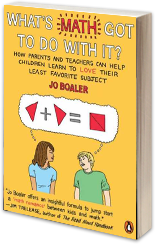
The recent book What's Math Got To Do With It? (subtitle: How parents and teachers can help children learn to love their least favorite subject) opens in the real-life classroom of an "amazing and unusual teacher". Her class is tackling a math problem as a group challenge. The atmosphere is animated and jovial, the students jump up eagerly to offer ideas and debate approaches, and "within ten minutes, the class has solved the problem by drawing from trigonometry and geometry, using similar triangles and tangent lines".
The book goes on to describe how most students despise mathematics, and grow up to become math-illiterate adults who use only "folk mathematics" instead of anything they were taught in school. The author presents the enthusiasm-building activities of the "amazing and unusual teacher" as the ideal form of math education, and suggests that if everyone were taught in such an engaging social environment, the public would come to love math and integrate it into their lives.
I disagree. I suggest that students are right to recoil from trigonometry and geometry, similar triangles and tangent lines. This style of mathematics is about translating a problem into symbolic abstractions, and then performing meaningless symbolic manipulation to get an answer. Regardless of how it's taught, most people will never be comfortable entering this level of abstraction in order to explore the problems of their lives.
They may not need to. Symbolic methods were invented in another era, tools intended to interface with pen and paper. We now live in an era of machines that can depict concrete visual representations of a problem, machines that can quickly iterate through enormous systems of differential equations, machines that can instantaneously draw plots for visual inspection, machines that can recalculate and redraw at the user's whim.
Why are we stuck teaching symbols?
Imagine: Instead of writing abstract equations, we draw a model to simulate in software. Instead of trying to make sense of algebraic results, we interactively explore parameter spaces using graphical visualizations. Instead of getting "an answer", we get an understanding. And instead of limiting our scope to that tiny subset of problems which can be solved analytically, we let our curiosity run wild, asking "what if" about anything we can model.
Such software will enable people to answer questions that affect their lives, without having to construct arcane abstractions. My hope is that this software will become as ubiquitous as the pocket calculator used to be. It will be the calculator of the next century.
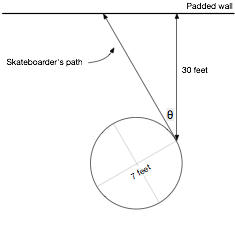
The math problem which enraptured the classroom above is as follows:
A skateboarder holds on to the merry-go-round pictured to the right. The platform of the merry-go-round has a 7-foot radius and makes a complete turn every 6 seconds. The skateboarder lets go at the 2 o'clock position in the picture, at which time she is 30 feet from the padded wall. How long will it take the skateboarder to hit the wall?
Set aside for a moment that nobody would ever be faced with this particular problem as stated, nor care about the result. We will use the situation it describes to explore more interesting questions.
But first, the conventional solution, as provided by the book. You do not need to read this — merely note how abstract, arcane, and contrived it is.
The first step is to find out how far the skateboarder travels after letting go. In other words, we need to figure out the distance AB in the drawing to the right.
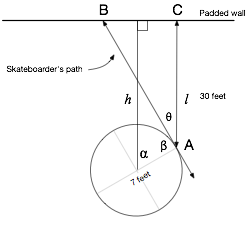
To do this we first need to work out what the angle θ is so we can use the properties of right triangles. To do this, draw the line h that passes through the center of the merry-go-round and meets the padded wall at a right angle. Since the skateboarder is at the "2-o'clock" position, whcih is 1/6 of the way around a clock, the angle α is 1/6 of 360°. So α = 60°. The angle β = 90°, since a tangent line of a circle always meets the radius at a right angle. Finally, α + β + θ = 180, since they are same-side interior angles between the parallel lines h and l. Therefore θ = 30°. This means that triangle ABC is a 30-60-90 triangle! Using the side relations of 30-60-90 triangles, we find:
BC = 30/sqrt(3) = 10 sqrt(3) feet
and
AB = 20 sqrt(3) feet
So now we know how far the skateboarder travels. The next step is to figure out how fast she is traveling. The merry-go-round makes a complete turn every 6 seconds. In a complete turn, the skateboarder travels the entirety of the circumference, which is
C = 2π (7) = 43.98 ft.
So the skateboarder is traveling at 43.98 / 6 = 7.330 feet per second.
Since
(distance) = (rate)(time)
then
(time) = (distance)/(rate)
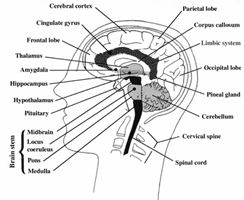
So the time it takes the skateboarder to reach the wall is
20 sqrt(3) / 7.330 = 4.726 seconds
Abstract. Our picture, which used to depict only objects that were meaningful to the problem (carousel, wall, skateboarder), has become cluttered with extraneous lines and symbols, like a diagram in an anatomy textbook. The solution is performed in terms of these symbols, not meaningful values.
Arcane. Mysterious rules are recited like sacred edicts: A tangent line of a circle always meets the radius at a right angle. Same-side interior angles between the parallel lines sum to 180°.
Contrived. Behold the convenient appearance of the 30-60-90 triangle.
All this, and still — the solution is wrong. The three-decimal-point precision is already laughable, given the precisions of the lengths and velocities in the problem. But what about the size of the skater herself? (An arm length of 2 feet adds a lot to the carousel's 7-foot radius!) What about deceleration of the skater due to friction? (Can she really coast for 30 feet without losing most of her momentum?) What about the non-constant velocity of the carousel, which is presumably being pushed by a friend at some interval?
We conventionally ignore such "non-idealities". Not because they aren't important, but because they complicate our symbolic manipulation, or even render it impossible.
My solution to the problem is as follows. Click it to watch.
This is a software simulation of the situation described in the problem. This gives the same result as the analysis above, so it clearly must be a valid solution.
Furthermore, this solution is not abstract: only concrete, meaningful objects are shown. It is not arcane: the only "rule" used is that the skateboarder maintains her speed and direction after letting go of the carousel; the rest of the model is physically obvious. It is not contrived: adjust any parameter of the original problem, and the simulation will provide the correct answer just as easily.
Because this solution was intended to match the analytic one, inaccuracies and all, it doesn't incorporate any "non-idealities". But it could, and could easily. Many non-idealities, such as gravity, friction, and drag, are fairly simple to incorporate into iterative models. (This is because iterative methods mimic how nature itself solves these problems, by integrating forces.) We traditionally avoid these non-idealities only because we have trouble "shortcutting" to the solution with symbolic trickery.
I implemented this example by "writing code". But to be clear, I am absolutely not advocating "code" as the means for solving such problems. I envision a tool that allows people to model the situation directly and concretely, perhaps by simply drawing a picture. The examples in this essay are only meant to show what a solution might look like, not how to make it.
Now, let's make the problem more interesting.
The simulation above gives a wonderfully visual interpretation of the solution. But one can't help but notice that there's not much solution to visualize — the result is just a number. This implies that the question isn't very interesting.
An interesting problem should bring delight when the solution is revealed, like a mystery story. As with a mystery story, the delight comes from achieving an understanding. How does "4.72 seconds" help us understand anything about the skateboarder's situation? Why is that number even meaningful?
Here's a characteristic that is intrinsically interesting: optimality. Even when it doesn't objectively matter, people care about finding the fastest route home from work, or the apartment with the most square footage, or the best deal on orange juice in the grocery store. People like to optimize. So, let's ask this question:
In order to reach the wall as quickly as possible, where should the skateboarder let go?
Astonishingly, the standard approach to this problem requires calculus, which few students learn and fewer use outside the classroom. Optimization is one of the most important uses of mathematics — shouldn't even our most elementary mathematical tools support it? Click to see a conventional solution.
My solution to this problem is as follows. Watch the plot fill in, and then try moving your mouse around the plot to see different trajectories.
This solution required no changes to the model — we merely sweep one of the parameters and find the minimum. But look at the beautiful result. The result is no longer just a number — it's a point on a plot. And every point on that plot is tied to a visual trajectory. We have context. We aren't merely given the optimal angle; we are presented with why it's the optimal angle, because we can see all the trajectories for all the angles. We can understand the situation.
Notice that if the skateboarder lets go anywhere on the left side of the carousel, she'll never reach the wall at all! (This is the red half of the plot.) Did you realize that this would happen when you read the problem statement? Would you have noticed it in the analytic solution's pile of equations? Most likely, you would have only noticed it if the problem explicitly asked us to solve for it. Modeling broadens our view of a situation, allowing us to see things that we don't yet know to look for.
Now, look at that optimal trajectory again:
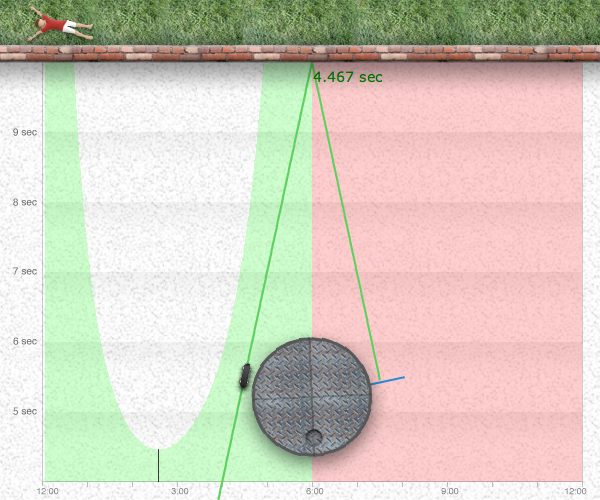
There's a symmetry here which is very conspicuous. The trajectory appears to hit the wall directly above the carousel's center. And after bouncing off, it appears to pass tangent to the other side of the carousel.
There's a lot that we could explore here. But upon seeing this, a real skateboarder would naturally think of a sweet trick: let go of the carousel, bounce off the wall, grab back on to the carousel on the other side, and go around again:
Let's take that idea and make the problem more interesting.
Contrived school problems are filled with straight lines and simple curves. But real life is more varied, more fun. What if our wall had a more artistic shape?
With curved wall below, where should the skateboarder let go so that she can bounce and grab back on?
The solution:
This is a fascinating result. There are now three places where the skateboarder can let go and rejoin the carousel! Furthermore, those places correspond to local minima and maxima of the time to the wall. Would you ever have predicted that?
Note that this problem cannot be solved analytically. Why? Because there is no formula for the shape of the wall. I simply drew it so it looked good. And so it is with many phenomena that we care about in the real world — their properties are what they are for artistic or natural reasons, not because they can be conveniently expressed analytically. If our mathematical tools can't deal with the objects we care about, then we are stuck in the land of artificial, contrived problems. No wonder people find math irrelevant!
The unexpected multiple solution to this problem inspires a new problem, the most interesting one of all.
In the previous two problems, the skateboarder could only bounce off the wall at very specific spots if she wanted to rejoin the carousel. Can we make it easier on her?
Can we design a wall such that the skateboarder can let go anywhere, bounce off, and perfectly rejoin the carousel?
This might be easy if we fully understood the criteria for bouncing and rejoining. But we don't yet — we only have hints. So let's allow the simulation to design the wall for us:
It's a circle. But why? Let's look at the three examples — the straight wall, the curvy wall, and the circular wall. What do the bounce-and-rejoin points all have in common? With a little thought, we can see that these are the points where a perpendicular line from the wall intersects the center of the carousel:

Because every point on the circular wall has a normal which goes through the center of the carousel, the skater can hit the circle anywhere and bounce back to the right place.
The four problems above, respectively, are examples of how a simulation tool might allow people to solve problems in a way that is:
Concrete. Modeling lets us set up and solve problems in a concrete domain, without translating to and from abstractions. Keeping the solution grounded in the problem domain makes it palatable to many more people, makes it easier to reality-check, and encourages exploration of related problems.
In context. Simulation and visualization give us a broader understanding of the situation. Simulation shows us not just the final answer, but the path taken to get there. Visualization encourages us to see the solution as a point on a plot, not a number in isolation.
Unrestricted. Simulation handles non-analytic situations with ease. The conditions of a problem do not need to be contrived or compromised for a convenient symbolic representation.
Generative. A simulation tool can be used for design, not merely analysis. Guided by human creativity and insight, the tool can construct designs and help explore their implications.
There are four critical issues that are not addressed by this essay.
The tool. I am proposing a software tool that allows people to pose and explore problems directly and concretely, a tool that should become as ubiquitous as the pocket calculator. What is this tool? What would its interface look like? How could it be designed so problems can be posed and solved quickly and casually?
Relevance. The tool and these methods should allow people to explore problems relevant to their lives. The example I followed here was almost a straw man, in that it's a school exercise — a problem that nobody would care to solve anyway. We need to compile a corpus of real, motivating problems — problems that people desperately want to explore, but currently cannot.
Universality. The example I explored here was a physics problem, which has a convenient visual representation and physically intuitive rules for evolving the system. Most of the problems in people's lives cannot be expressed as physics problems. How can non-physical problems be modeled concretely, visually, tangibly? How can we specify the rules for iterating these systems without succumbing to abstraction?
Benefits of symbols. Many scientific disciplines currently strike an uneasy balance between symbolic and numerical methods, aware of the pitfalls of both. The benefits of analytic methods can be:
Practical, such as finding with certainty all possible solutions to a problem.
Cognitive. Some teachers claim that automated solvers can be crutches that impair students' ability to reason.
Social. You can discuss or google a formula to learn from others who have navigated similar territory, but how do you look up or make reference to a plot or a process?
How relevant are these analytic strengths to the sorts of problem-solving we are concerned with here, and how can a simulation tool match or make up for them?
And on the other hand, how much does it matter if simulation falls short of symbolic methods in some respects? Most people use no mathematical methods at all beyond arithmetic. So, any high-level mathematical tool that could gain any following could be considered a success. Anything is better than nothing.
But I believe that a truly revolutionary simulation tool can beat symbolic methods at their own game.